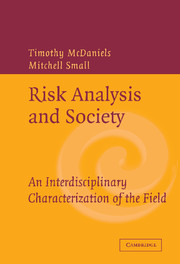Book contents
- Frontmatter
- Contents
- Contributors
- 1 Introduction – Risk Anaysis and Society: An Interdisciplinary Characterization of the Field
- PART ONE FUNDAMENTAL CHARACTER OF RISK
- PART TWO METHODS FOR RISK ASSESSMENT
- 6 Uncertain Risk: The Role and Limits of Quantitative Assessment
- 7 Valuing Risk Management Choices
- 8 The Role of Efficiency in Risk Management
- PART THREE NEW APPROACHES AND NEEDS FOR RISK MANAGEMENT
- SUMMARY AND FUTURE DIRECTIONS
- Index
- References
8 - The Role of Efficiency in Risk Management
Published online by Cambridge University Press: 05 June 2012
- Frontmatter
- Contents
- Contributors
- 1 Introduction – Risk Anaysis and Society: An Interdisciplinary Characterization of the Field
- PART ONE FUNDAMENTAL CHARACTER OF RISK
- PART TWO METHODS FOR RISK ASSESSMENT
- 6 Uncertain Risk: The Role and Limits of Quantitative Assessment
- 7 Valuing Risk Management Choices
- 8 The Role of Efficiency in Risk Management
- PART THREE NEW APPROACHES AND NEEDS FOR RISK MANAGEMENT
- SUMMARY AND FUTURE DIRECTIONS
- Index
- References
Summary
INTRODUCTION
Citizens throughout the world are demanding that their governments do a better job of investing resources in preventing, reducing, or mitigating risks to human health, safety, and the environment. If resources were limitless, nations could pursue a risk-free society. Yet citizen desires for risk reduction are constrained by the scarcity of resources of various forms (e.g., skilled and unskilled labor, capital, and even political energy). In fact, the resources devoted to protecting health, safety, and the environment could be used to serve other valuable public and private purposes, such as improving the quality of education, providing more day care services for parents and children, enhancing transportation networks, accelerating computer literacy, or buttressing criminal justice systems. The resources devoted to accomplishing ALL social objectives, including risk reduction, should be expended wisely and thus inefficient expenditures that accomplish little risk reduction should be questioned, unless policy makers have confidence that the diverted resources will be drawn from other sectors that are even less efficient than the proposed risk management measure. This comparison of alternative resource investments is exactly what analyses of economic efficiency do.
In recent decades, there has been significant progress, both intellectually and practically, in efforts to define and implement efficient approaches to managing risks. The purpose of this chapter is to review, for the nontechnical and noneconomist reader, the state of the art of the art of scientific approaches to efficiency in risk management.
- Type
- Chapter
- Information
- Risk Analysis and SocietyAn Interdisciplinary Characterization of the Field, pp. 251 - 286Publisher: Cambridge University PressPrint publication year: 2003
References
- 2
- Cited by



